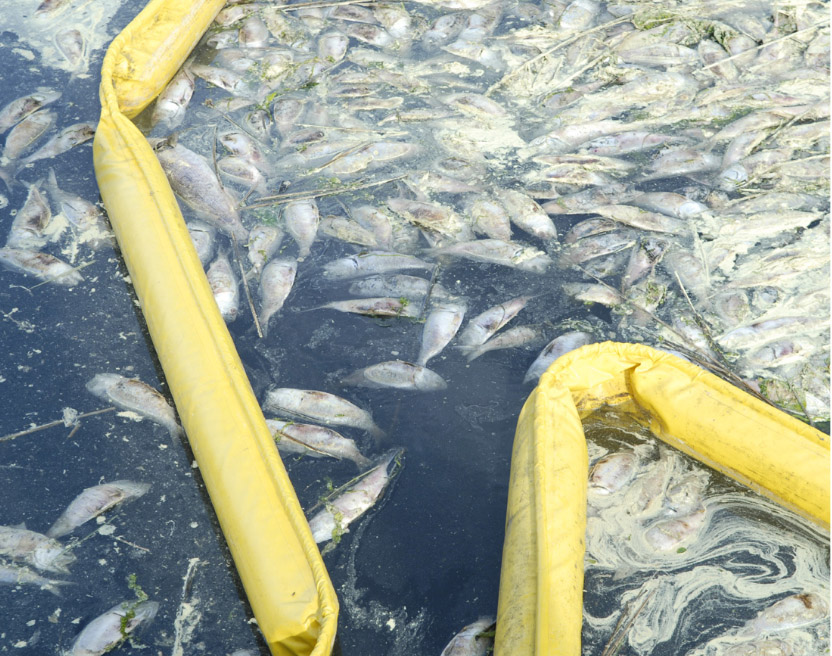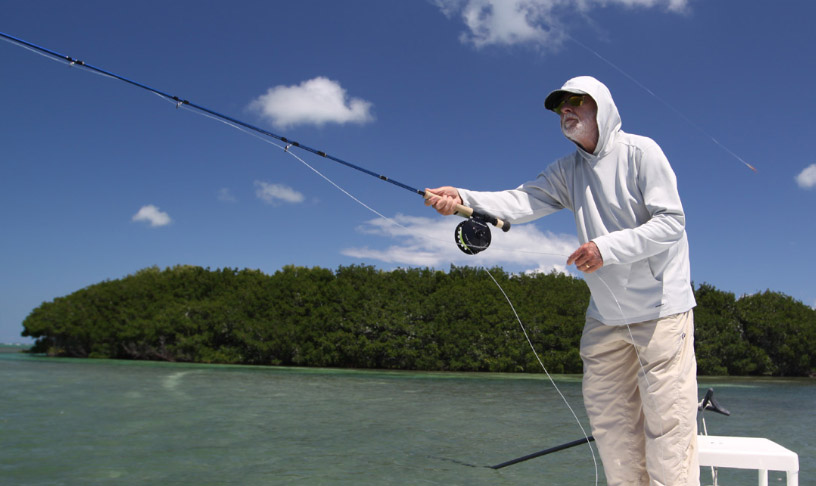Peconics to the Everglades:
THE BATTLE OVER WATER
by Tom Schlichter

Lifting off from John F. Kennedy Airport late this spring, the skies were clear, the horizon vast and the seas below looked calm. I was on my way to Islamorada for a shot at tarpon, snook and redfish as I settled contently into my window seat with visions of trophy predators dancing across shallow grass flats painting the inside of my eyelids.
Nothing could put a damper on that flight, I figured, until I looked down at the coast a few minutes later. The winds had been mild for several consecutive days and it hadn’t rained in more than a week but virtually all the inshore bay waters below us were tinted brown, and semi-circles of discolored water surrounded the inlets at each major port we passed. Off New York and Barnegat Bay, at the mouths of Delaware and Chesapeake bays, across the flats of North Carolina and right on down to the Florida coast, it looked as if some manner of discoloration encircled every substantial population center that bordered the East Coast. Yuck!
I’ve made the trip to southern fishing destinations before but had never noticed such consistency in the appearance of off-color seas. On this journey, however, with little in the way of foul weather to create runoff issues, there was no escaping the conclusion that despite decades of efforts to preserve, protect and improve coastal water quality we are still losing the battle.
Thus, it’s comes as little surprise to me that water woes have been making splashes in the headlines of Long Island newspapers in recent months. I am disheartened, however, at how little I’ve heard on the subject from politicians – even those currently up for election this month – leading up to this point. How it is that the quality of our water – for drinking, fish and wildlife habitat plus recreational enjoyment – is not at the forefront of top-level discussions every single day leaves me baffled.
All this isn’t to say that there haven’t been improvements in water quality on a local level in recent years. We have upgraded wastewater treatment facilities on the western Long Island Sound, for example, leading to a significant drop in nitrogen discharge for that area. Numerous sub-aqueous and shoreline habitat restoration programs are currently under way along both the north and south shores. Oyster farms are thriving in Peconic Bay. Long Island Sound, the South Shore Estuaries and Peconic Bay all now have in place general management plans, and new fish ladders and dam removals are improving river passage for fish species such as alewives and American eel. This summer, Wickham’s Fruit Farm in Cutchogue won an Agricultural Environmental Management Award – New York State’s top honor for outstanding efforts of a farm to protect and preserve soil and water quality. Hip, hip, hooray!
But that hasn’t been enough, as anyone who fishes the back reaches of Great South, Moriches, Quantuck or Flanders Bay during a “bloom” event can attest. One outdoorsman told me he recently gave up recreational clamming altogether. Seems that even the safe places to dig a few little necks are generally closed due to heavy boat traffic on the holidays he has off and are shut down following every heavy rain in any case.
Water quality issues affect our freshwaters as well. Most are choked with weeds fed by fertilizer runoff. Nuisance weed species like Ludwigia and Mosquito Fern have clogged the Peconic River to the point of slowing the current, which makes the waters there even more susceptible to algae blooms in the ever-increasing summer heat of a warming global environment. It’s not a pretty picture looking forward.
“Here on Long Island, the real culprit,” explains Christopher Gobler, professor of marine science at Stony Brook University, “continues to be nitrogen and phosphorus, which seep into our ground waters primarily from septic tanks, cesspools and outdated wastewater treatment plants.”
It is these sources that spur weed growth and feed the bacterial blooms responsible for coastal brown tides, rust tides and blue-green algae in freshwater that consume oxygen, create dead zones and otherwise foul our waters.
Gobler recently headed a Stony Brook University study that analyzed summer water quality at 29 Long Island locations. That analysis rated 11 as being in good condition, 16 as fair and two as poor. Water quality monitoring in Queens and Nassau counties by the organization Save the Sound found elevated levels of fecal bacteria at a number of sites as well.
“Half the samples we collected this summer failed to meet the criteria for safe swimming conditions,” said Tracy Brown, director of Save the Sound’s Western Long Island Sound program. “ That’s unacceptable. People swim, fish, boat, and wade in some of these waters—they need to be reliably clean. The good news is that the problems are fixable. We applaud local leaders who are taking water quality seriously by investigating and repairing broken sewer pipes and other causes of bacterial pollution.”
“Not as bad as I thought,” remarked a fishing acquaintance when we discussed these results while awaiting the arrival of false albacore in late September. Really? Are we okay now with broken sewer pipes, contaminated groundwater plumes and “fair” water quality as the norm these days?
True, grass roots organizations and select politicians have begun to respond more urgently to the call for help, but there is no doubt that anglers and the citizenry in general need to make more of a stink. We need to raise awareness and demand real solutions from our political leaders and the government agencies in charge of monitoring and maintaining water quality if these pollution problems – and that’s exactly what they are – are going to be overcome. The status quo and “fair” water quality ratings simply will not do.
From a big picture point of view, it will be necessary to fix and upgrade existing wastewater infrastructure, expand existing sewer infrastructure where appropriate, and exchange old cesspools and septic tanks, especially on the East End of Long Island, for new treatment technologies. That, however, is going to take time and cost bundles of money, which means it will be important to support whatever tax mechanisms are ultimately proposed to bring things up to date.
Not being discussed openly at this point, but sure to be necessary somewhere down the line, will be some kind of strategic retreat from the shoreline in which select residential, farmland and industrial property in sensitive drainage areas will need to be purchased by the government in order to reestablish large and significant buffer zones to protect our coastal waters and groundwater aquifers. It’s an idea that needs to be considered sooner rather than later.
On a smaller scale, concerned citizens can also make a significant difference by limiting their footprint in relation to groundwater pollution. This entails creating buffers of natural vegetation between cleared land and the water, using slow release fertilizers which are less likely to end up in the groundwater supply than standard, less expensive fertilizers, and using fertilizers as sparingly as possible.
Choosing native plants that don’t require fertilizer is another option, as is simply allowing some of your yard to remain in a natural state. That last choice will also help bees, butterflies and other pollinators, all of which are currently stressed by the reliance on a limited assortment of commercially grown shrubbery and garden selections as well as the chemical pesticides used to keep them looking so neat and pretty. A visit or letter to your town, county and state officials, as well as attending public hearings on water quality issues, should also be on the list.
To be sure, water quality issues are rising to the surface across the country and at the federal level water protection is given serious consideration, but the diversity of problems helps prevent a unifying voice when it comes to demanding large-scale change. In the west, for example, the overriding water-related concern right now is simply having enough to meet drinking and agricultural needs. In the Great Lakes region, industrial contaminants are still a primary concern. Along most of the East Coast, nitrogen and phosphorous continue to be the culprit. But clean water is vital to everyone and sportsmen need to band together to provide support to those who will take on these challenges no matter where they arise.
That’s exactly what has been going on in southernmost Florida, where no less than Florida Bay and the expansive Everglades system are in danger of destruction.
“We’ve had a terrible degradation of our Florida Everglades estuary,” says saltwater fly- fishing legend, angler and outfitter, Sandy Moret. “Freshwater naturally is supposed to flow from the Kissimmee River, through Lake Okeechobee, down through the central part of the state and out Shark River and Florida Bay to create an estuary system. That water has been cut off. It’s been managed for decades to the benefit of the big sugar companies which control roughly half-a-million acres where they grow sugar cane. The government and Florida State Legislature, in my opinion, manage the water here that is supposed to flow down and refresh the Everglades specifically at the request of the sugar lobby.”
This is just another example of how water issues are everyone’s problem. Many Long Islanders and Northeast anglers spend time in southern Florida in pursuit of tarpon, snook, bonefish, permit and other game fish. Quite a few, in fact, live there during the winter or hope to retire to the area at some point in the future. But even here, in the vastness of the Everglades, water problems threaten to destroy the magic.
“Water management corruption goes right to the top here in Florida. At least that’s how many of us see it,” continues Moret. “Big Sugar, I believe, has influenced every level of government to their benefit and to the detriment of the Everglades environment, anglers, drinking water supply, and wildlife that inhabit this unique and diverse environment.”

Florida’s sportsmen and environmentalists eventually got so fed up with lack of progress in resolving this issue that they formed their own PAC (Political Action Committee) called www.bullsugar.org and a second organization, www.gladesdeclaration.org. Driven by donations and focusing on social media, these groups have been pressuring government officials to institute change and are finally making progress. Recently, in fact, the Florida State Legislature’s incoming senate president committed to propose a bill to purchase some 60,000 acres of sugar land immediately south of Lake Okeechobee to increase water storage and filtration creating a southward flow. Still, it’s not coming fast enough. Some policy makers and agencies continue to propose delay of action on the purchase for another five years.
“We’ve got the keep the heat on,” says Moret, “because it will take years to repair the plumbing to bring freshwater from Lake Okeechobee trickling down into the Everglades. The fishing here is still fantastic, overall, but adding another five years on to that timeline with a delayed purchase, I just don’t know that the Everglades can hold out that much longer.”
Nor can Long Island’s drinking aquifer, freshwaters and coastal waters – or our fishing. The time for action is now both on a personal and communal level. Every day we delay only compounds the problems.









